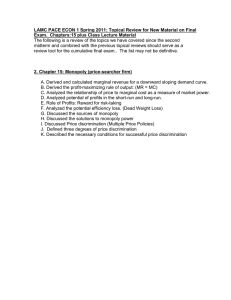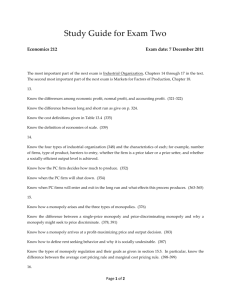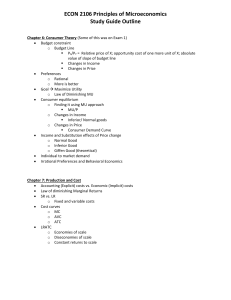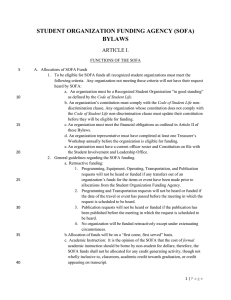Simon Fraser University Spring 2016 ECON 302 S. Lu
advertisement
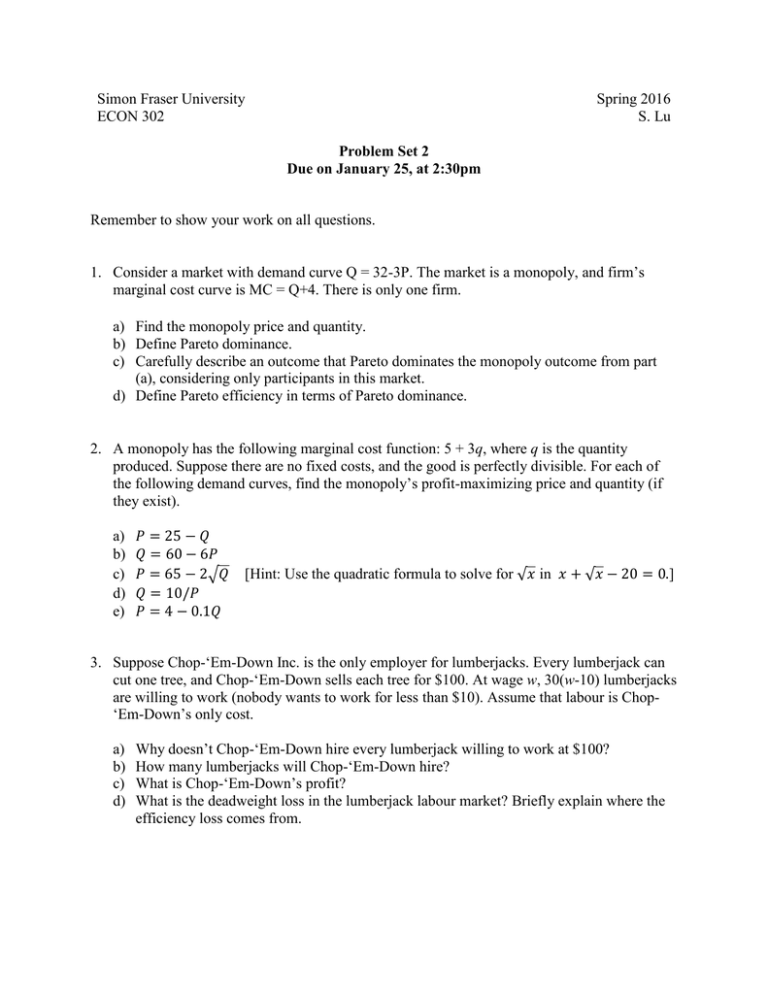
Simon Fraser University ECON 302 Spring 2016 S. Lu Problem Set 2 Due on January 25, at 2:30pm Remember to show your work on all questions. 1. Consider a market with demand curve Q = 32-3P. The market is a monopoly, and firm’s marginal cost curve is MC = Q+4. There is only one firm. a) Find the monopoly price and quantity. b) Define Pareto dominance. c) Carefully describe an outcome that Pareto dominates the monopoly outcome from part (a), considering only participants in this market. d) Define Pareto efficiency in terms of Pareto dominance. 2. A monopoly has the following marginal cost function: 5 + 3q, where q is the quantity produced. Suppose there are no fixed costs, and the good is perfectly divisible. For each of the following demand curves, find the monopoly’s profit-maximizing price and quantity (if they exist). a) b) c) d) e) 𝑃 = 25 − 𝑄 𝑄 = 60 − 6𝑃 𝑃 = 65 − 2√𝑄 𝑄 = 10/𝑃 𝑃 = 4 − 0.1𝑄 [Hint: Use the quadratic formula to solve for √𝑥 in 𝑥 + √𝑥 − 20 = 0.] 3. Suppose Chop-‘Em-Down Inc. is the only employer for lumberjacks. Every lumberjack can cut one tree, and Chop-‘Em-Down sells each tree for $100. At wage w, 30(w-10) lumberjacks are willing to work (nobody wants to work for less than $10). Assume that labour is Chop‘Em-Down’s only cost. a) b) c) d) Why doesn’t Chop-‘Em-Down hire every lumberjack willing to work at $100? How many lumberjacks will Chop-‘Em-Down hire? What is Chop-‘Em-Down’s profit? What is the deadweight loss in the lumberjack labour market? Briefly explain where the efficiency loss comes from. 4. Sit-‘N-Sleep Inc. is the only seller of sofa beds in a remote town. Its total cost for producing 20 q sofa beds is 50,000 + 3 𝑞1.5 . The demand for sofa beds in town is 𝑄𝑑 = 2400 − 2𝑃. a) What is Sit-‘N-Sleep’s profit as a function of q? b) Sit-‘N-Sleep maximizes profits. How many sofa beds will it produce, and at what price will they sell? c) What is the price elasticity of demand at the quantity you found in part b? Use one of the markup formulae derived in lecture. d) Do part c again, this time directly using the definition of elasticity. (You should of course get the same answer.) e) What quantity of sofa beds maximizes social surplus? f) The government tries to achieve the quantity from part e through a per unit subsidy. How much should this subsidy be? Briefly comment on its size. 5. Assume that market demand is linear. a) Show that a profit-maximizing monopoly with constant marginal cost produces half the efficient quantity. b) If the firm instead has increasing marginal cost, does it produce more or less than half the efficient quantity (assuming the latter is positive)? Explain.

